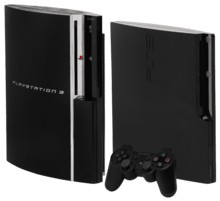List of PowerPC-based game consoles
| Power Architecture |
|---|
| Made by Freescale |
| Made by IBM |
| IBM-Nintendo collaboration |
| Other |
| Related links |
| Cancelled in gray, historic in italic |
There are several ways in which game consoles can be categorized. One is by its console generation, and another is by its computer architecture. Game consoles have long used specialized and customized computer hardware with the base in some standardized processor instruction set architecture. In this case, it is PowerPC and Power Architecture, processor architectures initially developed in the early 1990s by the AIM alliance, i.e. Apple, IBM, and Motorola.
Even though these consoles share much in regard to instruction set architecture, game consoles are still highly specialized computers so it is not common for games to be readily portable or compatible between devices. Only Nintendo has kept a level of portability between their consoles, and even there it is not universal.
The first devices used standard processors, but later consoles used bespoke processors with special features, primarily developed by or in cooperation with IBM for the explicit purpose of being in a game console. In this regard, these computers can be considered "embedded".
As of early 2017, there are no currently-announced new game consoles based on PowerPC or Power Architecture. The most recent release, Nintendo's Wii U, has since been discontinued and succeeded by the Nvidia Tegra-based Nintendo Switch. However, the PlayStation 3 and Wii, while having also since been succeeded, still remain in production in some markets.
List
| Name | Image | Manufacturer | Generation | CPU | Clock | RAM | On the market | No. sold |
|---|---|---|---|---|---|---|---|---|
| Pippin |  |
Apple Bandai Katz Media |
5th | PowerPC 603 | 66 MHz | 6 MB | 1995–1997 | 42.000 |
| M2 | 3DO Panasonic |
5th | 2× PowerPC 602 | 2× 66 MHz | 8 MB | 1997 Never marketed |
none | |
| GameCube |  |
Nintendo | 6th | Gekko | 486 MHz | 24 MB | 2001–2007 | 21.74 million |
| Xbox 360 |  |
Microsoft | 7th | XCPU (Xbox 360) XCGPU (Xbox 360 S and Xbox 360 E) |
3.2 GHz | 512 MB | 2005–2016 | 84 million June 2014 |
| Wii |  |
Nintendo | 7th | Broadway | 729 MHz | 64 MB | 2006–2017 | 101.63 million March 2016 |
| PlayStation 3 |  |
Sony | 7th | Cell B.E. | 3.2 GHz | 512 MB | 2006–2017 | 80 million November 2013 |
| Wii U | Nintendo | 8th | Espresso | 1.24 GHz | 2 GB | 2012–2017 | 13.36 million September 2016 |